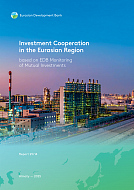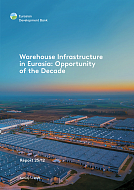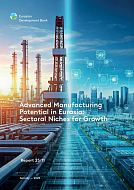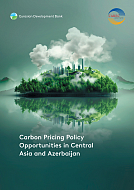-
Investment Cooperation in the Eurasian Region based on EDB Monitoring of Mutual Investments
The report contains detailed information on the scale, dynamics, geographical and sectoral structure of mutual foreign direct investment in the Eurasian region for the period from 2016 to the first half of 2025. For the first time, greenfield projects have come to dominate the region's investment structure, the share of FDI in the manufacturing sector is growing, and private business has become the main driver of investment growth. Central Asia is experiencing an investment boom. 11 December 2025 -
Warehouse Infrastructure in Eurasia: Opportunity of the Decade
Eurasia is entering a new era of logistics. A study by the EDB reveals that changes in the architecture of international trade within the region, coupled with the rapid growth of retail and online commerce, the industrialisation of the economy and the adoption of new logistics technologies, are generating an unprecedented demand for contemporary warehouses and distribution centres. By 2040, demand for warehouse infrastructure in the region is expected to almost double to over 120 million square metres. This comprehensive study is the first to assess the prospects for the warehouse real estate and logistics services market in ten Eurasian countries. It analyses key demand drivers and provides country- and segment-specific forecasts, as well as outlining the measures needed to unlock the sector's potential, from creating dry ports and multimodal hubs to introducing green standards, digital solutions, and PPP mechanisms. 23 October 2025 -
Advanced Manufacturing Potential in Eurasia: Sectoral Niches for Growth
For many years, countries in the Eurasian region have based their economies on exporting raw materials. While oil, gas, metals and minerals have provided foreign currency earnings, they have also made the economy vulnerable. New research shows that transitioning to high-value manufacturing can be a powerful driver of sustainable and rapid economic growth. This is the most effective way to reduce poverty, improve educational standards, and establish a broad middle class. The study identifies priority industries and niche markets for each country in the region. It provides detailed assessments of export potential (for 709 product categories) and import substitution potential (for 686 product categories) for specific products. 07 October 2025 -
Carbon Pricing Policy Opportunities in Central Asia and Azerbaijan
Carbon pricing is one of the most effective and widespread climate incentives, with 75 carbon pricing instruments (CPIs) in operation worldwide. The countries of Central Asia and Azerbaijan have different approaches to CPI implementation, ranging from having an ETS in place to carrying out initial discussions. Joint report by the Eurasian Development Bank (EDB) and the CAREC Institute (CI) provides a comprehensive analysis of the current status, prerequisites and prospects of carbon pricing instruments in Azerbaijan, Kazakhstan, Kyrgyzstan, Tajikistan, Turkmenistan, and Uzbekistan. The report also presents a Readiness Assessment Tool to facilitate the decision-making in this field, and makes recommendations to policymakers to help design an appropriate climate policy mix. 30 September 2025




